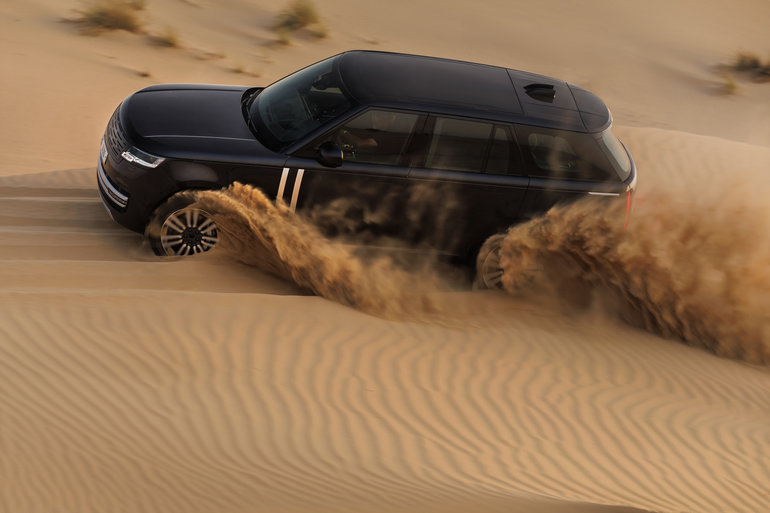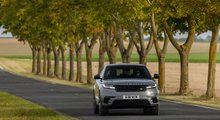How the 2026 Range Rover Electric's 800-Volt Architecture Changes the Luxury EV Game
November 12 2025,

The automotive industry stands at a technological crossroads, and Land Rover's approach to electrification reflects a deliberate choice: build for the future, not just for today. The 2026 Range Rover Electric marks the brand's entry into battery-electric vehicles with engineering decisions that prioritize long-term capability over short-term convenience.
For Montreal's luxury vehicle market, where expectations include both cutting-edge technology and uncompromising winter performance, the Range Rover Electric's technical foundation offers a distinct approach to premium electrification. The vehicle's 800-volt electrical architecture, MLA-Flex platform engineering, and extreme cold-weather validation create a flagship BEV designed for Canadian conditions rather than adapted to them.
Understanding 800-Volt Architecture
The transition from 400-volt to 800-volt electrical systems in electric vehicles involves more than incremental improvement. Higher voltage architecture enables faster energy transfer with reduced current, which translates to smaller, lighter cables and more efficient thermal management throughout the vehicle's electrical system.
For the Range Rover Electric, the 800-volt system supports rapid charging capability that current 400-volt infrastructure cannot match. When connected to compatible high-power charging stations, the vehicle can accept significantly higher charging rates than PHEVs or 400-volt BEVs. This reduces charging time during long-distance travel, a practical consideration for drivers who regularly travel between Montreal and destinations across Quebec or into Ontario.
The system's efficiency extends beyond charging speed. Reduced electrical resistance in the high-voltage architecture means less energy lost as heat during both charging and discharge cycles. In Quebec's cold winters, when battery performance typically degrades, this efficiency advantage helps maintain consistent range and performance when temperatures drop.
MLA-Flex Platform: Engineered for Multiple Powertrains
The Range Rover Electric debuts on Land Rover's Modular Longitudinal Architecture (MLA-Flex), a platform designed from its foundation to accommodate battery-electric, plug-in hybrid, and mild-hybrid powertrains. This flexibility allowed engineers to optimize the structure specifically for the weight distribution and packaging requirements of a large-capacity battery pack.
The platform features high-strength Boron steel battery protection engineered to withstand extreme off-road conditions. The battery casing can support the vehicle's full weight balanced on a single axle, validating Land Rover's commitment to all-terrain capability in its electric flagship. For a luxury SUV designed to handle everything from Montreal's urban environment to backcountry trails in the Laurentians, this structural integrity maintains the brand's capability standards in BEV form.
MLA-Flex delivers torsional stiffness up to 50 per cent higher than previous-generation architectures. This rigidity provides the foundation for the Range Rover Electric's refinement, reducing vibration transmission into the cabin and creating the silent, serene environment that defines Range Rover luxury. The electric powertrain's inherently quiet operation, combined with MLA-Flex's structural isolation, aims to deliver what Land Rover describes as the quietest Range Rover ever created.
Winter Validation: Engineered for Canadian Climate
Electric vehicle performance in severe cold represents a genuine engineering challenge. Battery chemistry, thermal management, and power delivery all face stress in sub-zero conditions. Land Rover's validation program for the Range Rover Electric included extensive testing at Arjeplog, Sweden, where temperatures reach -40°C, matching the most severe winter conditions in Quebec.
This cold-weather testing program validated the battery pack's thermal management system, ensuring reliable performance when Montreal temperatures plunge in January and February. The system must balance multiple requirements: maintaining optimal battery temperature for performance and longevity, providing cabin heating without excessive range penalty, and managing regenerative braking in low-traction conditions.
For drivers in Quebec, where winter driving represents more than just an inconvenience but a daily reality for several months, validation at -40°C provides confidence that the vehicle's systems will perform when needed. The thermal management system pre-conditions the battery and cabin while connected to charging infrastructure, using grid power rather than battery capacity to prepare the vehicle for cold-weather operation.
Performance Targets: V8-Equivalent Power Delivery
Land Rover has confirmed that the Range Rover Electric will deliver performance matching or exceeding current V8-powered models. This means instant torque delivery characteristic of electric motors, combined with the refinement and capability expected from the Range Rover nameplate.
Electric motors provide maximum torque from zero rpm, eliminating the lag associated with internal combustion engines. For Montreal drivers navigating winter conditions, this instantaneous power delivery provides precise control in low-traction situations. The vehicle's torque vectoring systems can distribute power to individual wheels with millisecond response times, far faster than mechanical differentials in traditional powertrains.
The performance targets also address highway driving dynamics. Electric vehicles often excel in urban acceleration but face efficiency challenges at sustained highway speeds due to aerodynamic drag and the absence of multi-gear transmissions. Range Rover's engineers focused on maintaining performance and efficiency during extended highway travel, relevant for drivers who regularly commute between Montreal and Quebec City or travel to the Eastern Townships.
Charging Infrastructure Considerations in Quebec
Quebec's public charging infrastructure currently operates predominantly on 400-volt systems, which raises practical questions about the immediate utility of 800-volt architecture. However, the technology represents future-proofing as charging networks expand and upgrade. Hydro-Québec's Electric Circuit includes high-power charging stations, and the network continues to expand with higher-capacity installations.
The Range Rover Electric maintains compatibility with current 400-volt infrastructure while maximizing charging speed when connected to emerging 800-volt stations. This dual compatibility ensures usability today while positioning the vehicle to take full advantage of infrastructure improvements over its lifecycle.
For home charging in Montreal, where many luxury vehicle owners have access to garage parking, the Range Rover Electric supports level 2 AC charging through a wall-mounted charger. Overnight charging provides a full battery for daily urban driving, with the vehicle's predictive energy management system optimizing charge timing based on electricity rates and departure schedules.
Market Positioning and Current Status
The official Canadian waiting list for the Range Rover Electric is now open, with global interest reflected in over 61,000 expressions of interest as of May 2025. Formal pre-orders will begin in 2025, with first customer deliveries anticipated in 2026.
This timeline places the Range Rover Electric in a specific competitive position within the luxury BEV market. Competitors including the Mercedes-Benz EQS SUV and BMW iX are already available, but Land Rover's delayed entry allowed engineers to incorporate more recent battery technology and charging architecture. The trade-off between first-to-market advantage and technological maturity will ultimately be determined by customer priorities.
For Montreal's luxury buyers, the Range Rover Electric represents a distinct proposition: a battery-electric SUV engineered specifically to maintain Range Rover's standards for refinement, capability, and luxury while addressing the practical requirements of Canadian climate and driving conditions.
Visit Decarie Land Rover in Montreal
The upcoming 2026 Range Rover Electric demonstrates Land Rover's approach to electrification: advanced technology supporting traditional brand values rather than compromise. The 800-volt architecture, MLA-Flex platform, and cold-weather validation create a luxury BEV designed for long-term ownership in challenging climates.
Our team at Decarie Land Rover in Montreal can provide detailed information about the Range Rover Electric's specifications, timeline, and reservation process. As Quebec's luxury vehicle market continues to evolve, we're positioned to help you understand how Land Rover's electric future aligns with your driving requirements.





